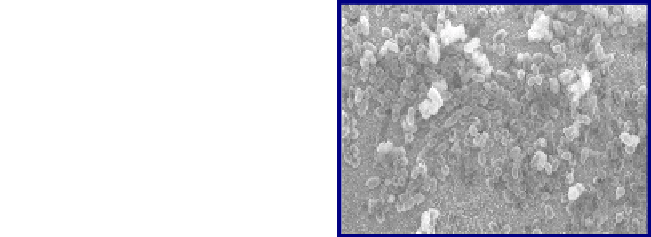Biomedical Engineering Reference
In-Depth Information
pure water and the resonant frequency of the biosentinel measured. The network ana-
lyzer scanned, measured and recorded the resonant frequency spectrum of the ME
biosentinel as a function of time. After each 30 min exposure the analyte was changed
to the next highest dilution. Figure 9 shows the frequency shift measurements for ME
biosentinels 500 × 100 × 4 µm in size. Note that the control sentinel shows a nearly
constant frequency (no frequency shift), while the measurement sentinel undergoes a
frequency shift of nearly 120 kHz. The ME biosentinel exhibited a sensitivity of near-
ly -24 kHz/decade and a detection limit less than 50 CFU/mL of
S.
Typhimurium in
water.
A scanning electron microscope (SEM) was used to confirm and compare the
binding of
S.
Typhimurium on the phage-coated measurement and control sentinels.
After the bacterial detection, the ME biosentinels were exposed to osmium tetroxide
(OsO
4
) vapour for 45 min. The sensors were then mounted onto aluminum stubs and
examined using the SEM. Figure 10 shows the SEM micrographs for the measure-
ment and control sentinels. The control biosentinel shows only a few cells are bound
to the surface while the measurement biosentinel is nearly completely covered with
bound
S.
Typhimurium bacteria.
Fig. 9.
Response of 500 µm long measurement and control biosentinels exposed to increasingly
higher concentrations of
S
. Typhimurium. The detection limit is less than 50 CFU/mL.
a
b
10 µm
10 µm
Fig. 10.
The SEM images show near zero binding of
Salmonella
cells to the control biosentinel
(a) and a large number of bound
Salmonella
cells to the measurement biosentinel (b).







Search WWH ::

Custom Search